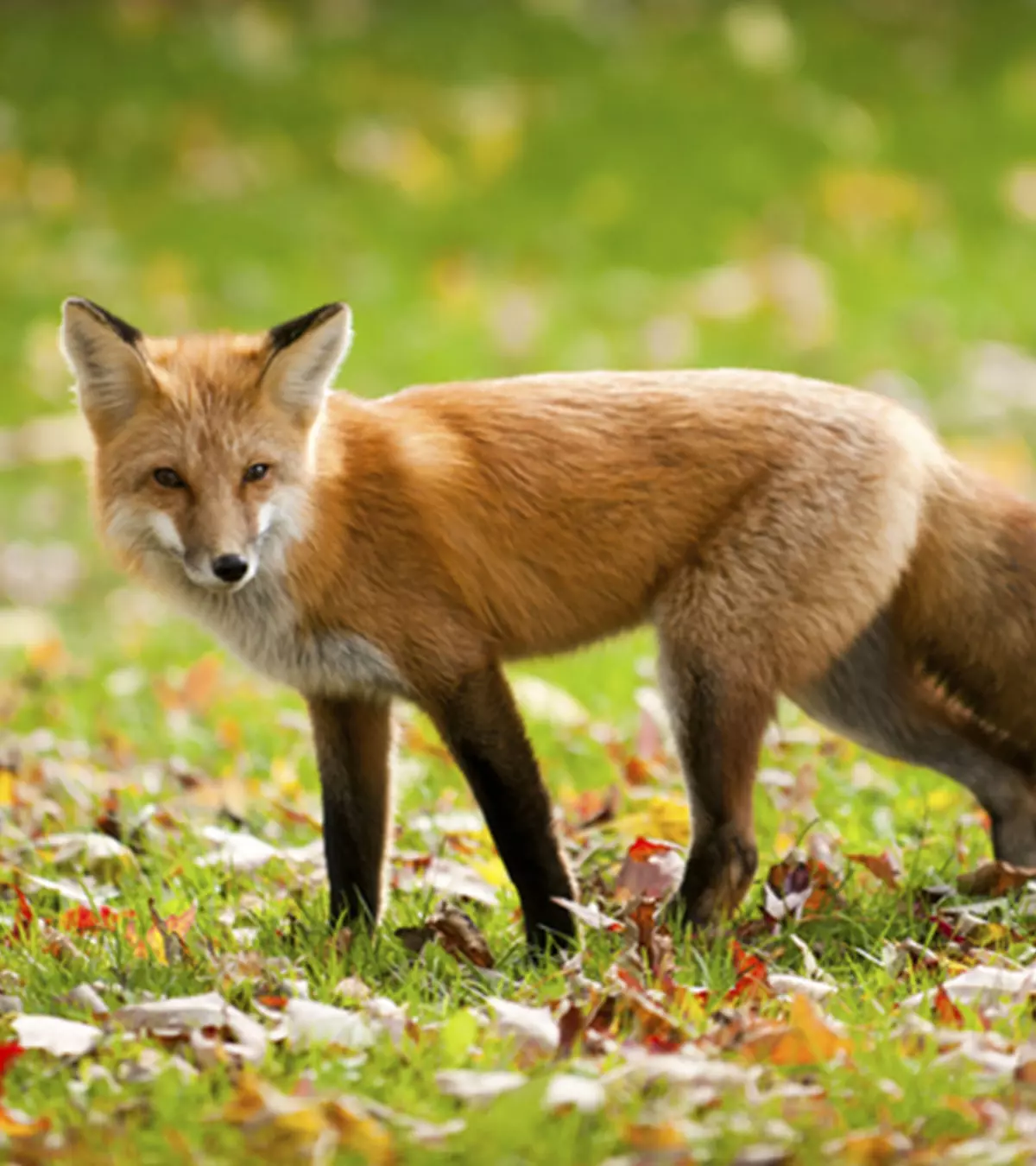

Image: Shutterstock
You might have read about Robin Hood’s portrayal as a fox in the 1973 Disney cartoon in childhood. Since foxes have been a craze for quite a long time, these fox facts for kids are guaranteed to create some interest in this animal. However, if they have not read much about foxes, then we have got you covered. We have listed some fascinating facts about foxes that you can consider reading to them. Learn about these lovely creatures’ history, habitat, lifestyle, food, and eating habits.

History Of The Fox
- Foxes are native to Britain, Europe, Asia and North Africa. They are one of the most well-known wild animals that are present today in the UK and were introduced to Australia sometime in the mid-19th century.
- The Latin name for a fox is Vulpes Vulpes.
- The Fox is part of the dog family, and other animals that are also part of its family include the wolf, the coyote, the gray fox, the jackal, the raccoon dog and similar other animals.
- All the members that are part of the fox and dog family are very adaptable creatures. As a result, they can stay in almost any part of the world and adapt to the climate and the food structure there. Most animals in this group prefer to live next to human habitats.
- The fox is known to be the smallest member that belongs to the dog family. While a fox can live up to two to five years in the wild areas, it can live up to be about 14 years in captivity.
- A fox is a medium sized animal and weighs anywhere between seven and 5 pounds. It has a pointed face, a lean frame, and a bushy tail. The tip of the fox’s tail is almost always white, whereas the tips of its ears and feet are almost always black.
- A fox can run at a very high speed, often reaching up to 30 miles an hour.
- A male fox is known as a dog while a female fox is known as a vixen.
- A fox can live anywhere, whether it is in the countryside or in a town.
- A fox marks its own territory with the smell of its urine.
- The red fox has about 48 sub-species which include foxes with different variations in the color of the fur and some of which are also referred to as the silver fox or the cross fox.
- Foxes are mostly solitary animals and like to be on their own, instead of moving around in a group.
- During the 16th century, fox hunting was a very popular sport in Britain. The aristocracy gave it a very special status and elevated it to a whole new level, turning it into a formal sport. The upper classes in Britain’s society would sit on horseback and use a pack of hounds to chase a fox till they would kill it.
- The fox is mostly hunted down for its fur and its tail is cut off by the hunters to show off as a hunting trophy, which is known in the hunting community as the ‘brush.’
- Some gamekeepers and farmers also capture foxes in snares.
- In the present time, hunting a fox with the help of a dog is not allowed anymore. Banning fox hunting is a very controversial topic in the UK today.
- In North America, you can find both the native as well as the non-native red foxes. The native foxes belonged to the Canadian Boreal Forest species and had appeared historically in the various parts of North America. About 11,000 years ago, the native foxes colonized in the area and stayed back. The non-native species of red foxes were brought in to the region by the early European settlers who wanted to use them for various hunting purposes, sometime around the mid-1700s.
- One of the most common types of foxes is the red fox. It can adapt to various climates and habitats; a red fox can be found in the entire area of the Northern Hemisphere. From the Arctic Circle to the northern parts of Africa, to Central America as well as the Asiatic steppes, and even in parts of Australia, where it is referred to as an invasive species.
- A fox is considered to be a friendly and a very curious animal. It likes to play with other foxes as well as other animals such as dogs and cats. Foxes also love to play with balls and often end up stealing balls from the golf courses around which they live. In some cases, a fox also plays with its prey before it kills it.
- The most common predators of foxes are mountain lions, bears, wolves, and coyotes.
- In the year 2011, researchers came across and opened a grave in Jordan in a cemetery that is believed to be 16,500 years old. In the grave, the researchers found the remains of a man along with his pet fox. The grave dates back to more than 4,000 years before the first known incidence in which a human being and a dog were buried together. As a result, researchers feel that the relationship that a human being and a fox share is older than the relationship that human beings share with a dog.
- Dmitry Belyaev was a Soviet geneticist who bred thousands of foxes during the 1960s, till he bred a domesticated fox. While a tame fox is one that learns how to tolerate human beings, a domesticated fox is one that will be soft and gentle towards human beings right from the time of birth.
- Buying a pet fox can cost you about $ 9000.
- The fox has been mentioned in folk lore through many generations. Some popular examples include the mention of the fox with the nine tails in many Asian cultures, the tales of Reynard that are popular in the medieval European culture, the mention of the sly trickster fox from the Native American folk lore, the fox and the crow story in Aesop’s fable and many more.
Habitat And Lifestyle Of The Fox
- The fox usually creates its den as a burrow under the ground. It is also referred to as the ‘earth.’ Alternatively, a fox is also able to live comfortably above the ground by making a cozy space in a hollow.
- Some common areas in which a fox likes to create its home are under the sheds, in underground burrows, in wood piles as well as in the hollow of trees.
- To give out its call of mating, a fox makes a sharp and high-pitched sound that is often very scary and terrifying. The sound is almost like a screaming or shrieking noise.
- The breeding season for a fox is during the winter months, when, despite its solitary status, it courts and mates with a prospective partner. While the mating season is on, the dog fox will court the vixen fox and help her by bringing her food as well as getting food for the entire family. In most cases, a fox will have a family by the time it is early spring.
- A fox has many characteristics similar to that of a cat. Both the fox and the cat can see better once it becomes dark. Also, both the fox and the cat have sensitive whiskers as well as a spine on their tongue. Both the animals also prefer to walk on their toes rather than using the entire paw. Also, very similar to a cat, many foxes prefer sleeping on a tree.
- A fox can climb on the tree and settle in comfortably on its lower branches.
- Just as a fox has whiskers on its face, it also has whiskers on its legs, which help it to find its way.
- The eyes of a fox are especially powerful during the night, as they are particularly adapted to the night time vision. The fox has another layer behind its light sensitive cells, and the layer is known as the tapetum lucidum. It helps to reflect the light back through its eyes and doubles the intensity of the image that the fox sees through its eyes.
- When you shine a light into the eye of a fox at night, it will shine green.
Food And Eating Habits Of The Fox
- The fox uses the magnetic field of the earth to help it hunt for food. Various other animals, such as turtles, sharks, and some birds also have this magnetic sense. However, the fox is the first animal that uses this sense to hunt for its prey.
- A Fox can see the magnetic field of the earth like a ring of shadow which reflects on its eyes. As it moves closer towards the magnetic north, the shadow darkens. Once the shadow matches the sound that the prey is making, the fox pounces to catch its prey.
- The fox is an omnivorous animal, which means it eats both animal and plant matter. It can eat almost anything, and some of the most common things that foxes eat include worms, spiders, insects, small birds, berries and even jam and toast or sandwich. If the fox lives near a farm, it will try to raid the hen house and eat up the chicken. In some cases, the fox can also eat up the vegetation on the farm.
- After a fox finds it food, it hides it from other preying animals so that it can enjoy it later.
- A fox does not chew its food but instead cuts up the meat into different sizes that it can easily eat up. It uses its carnassial or shearing teeth to cut up the meat.
- Once a baby fox is grown up enough to be able to have meat, the mother fox usually vomits up the food she has swallowed, so that she can feed her baby the same. These are some of the fun facts about foxes for kids to know.
Interesting Facts About Fox Cubs
- The baby of a fox is referred to as a cub.
- A fox gives birth only once a year. While the number of fox cubs could range from anywhere between one and eleven, on an average, a female fox will give birth to six fox cubs at a time.
- A fox likes to keep its family very small and not as a part of a group. The family of a fox is referred to as a ‘leash of foxes’ or a ‘skulk of foxes.’
- Once a female fox gives birth, a female cub from the previous litter or a female fox which is not breeding at that time will help the mother fox to raise the cub. The females who help care for the cub use it as a learning experience in taking care of the baby fox, which will help them later when they give birth.
- While the fox cub stays with its mother, the father fox goes out to hunt for food and bring it back for its family.
- At the time of birth, a fox cub has its eyes and ears closed. Once it is about two weeks old, its eyes and ears slowly start to open up.
- A fox cub has a very short nose which often makes it look like a puppy at the time of birth.
- Once a fox cub is about four weeks old, it comes out of its den for the first time.
- For the first seven months after it is born, a fox cub stays with its parents in the den.
- Unfortunately, most fox cubs die while they are still young. One of the biggest reasons for the same are the motor vehicles that they come in contact with after they first leave their den and venture out.
- There is also a host of other predators, including the dogs and the badgers which often end up killing the baby fox. A fox cub can also die early due to harsh winter conditions or the lack of food.
- Once a fox cub learns to hunt, it can catch small sized rodents by pouncing on them. The way it pounces on the rodents is one of the most well-known characteristics of a fox cub, and it is also one of the first things it learns once it begins to hunt.
Interesting Facts About The Arctic Fox
Here are some very interesting Arctic fox facts for kids that they love to read up on:
History Of The Arctic Fox:
- An Arctic Fox is a mammal and is part of the animal family that also includes wolves and different species of dogs and foxes.
- It is mainly found in Canada, Russia, Greenland, Norway, Alaska, Iceland, and Scandinavia.
- The Arctic Fox is the only native land mammal of Iceland.
- An Arctic Fox has very thick fur all over its body and even at the bottom of its paws, which makes it easier for the animal to move around in the snow.
- It also uses its thick bushy tail to keep itself warm in the cold climate, by wrapping it around its body.
- It also has short legs, pointy ears, and a short muzzle. The special body structure helps the arctic fox to retain its body heat in the cold environment.
- The arctic fox is usually small in size and can go up to a length of about 26 inches. It weighs anywhere between 6.5 and 17 pounds. Its tail is about 13.7 inches in length.
- Other than human beings, the main predators of arctic foxes are polar bears and red foxes.
Living Conditions Of The Arctic Fox:
- An Arctic fox is found in the northernmost parts of the hemisphere.
- It is able to tolerate extremely cold weather conditions better than most other animals on the earth and can easily feel comfortable even in temperatures of minus 70 degree Celsius.
- The white coat of the Arctic Fox acts as a perfect camouflage against predators.
- As the fox lives through various changes in the season, the color of its coat changes as well. The coat of the arctic fox can change from white to gray to brown, and helps it to blend in with its habitat, whether it is covered in snow, dirt or rocks. During the winter season, the coat of the arctic fox is usually white or a bluish white in color. During the spring season, the arctic fox will shed its fur and get a new coat which is brown or gray in color.
- An Arctic Fox lives in a burrow which can often have up to a hundred different entrance points. Most of these burrows are very old, some even as old as hundreds of years, and are used through many generations of the arctic fox.
- An Arctic Fox is a monogamous animal, which means that it usually takes only one mate for life and lives with the same partner for life.
- Once it finds its mate, it starts to live together with its mate for life. Both the partners are very playful and usually indulge in a lot of fun times.
- A female Arctic Fox will be pregnant for about 51 to 57 days.
- A baby Arctic Fox is known as a pup.
- A female Arctic Fox gives birth to about six to eight pups at a time. In some cases, she may also give birth to almost 13 to 16 pups at a time.
- Once the babies are born, both the Arctic Fox male and the arctic fox female continue to live together and raise their babies as a family.
- As they grow up, the male Arctic Fox babies will stay in the family whereas the female Arctic fox babies will go away to start their family with a male Arctic Fox.
Food And Eating Habits Of The Arctic Fox
- An Arctic Fox is an omnivorous animal, which means it can eat both meats and plants.
- The main source of food for an arctic fox is the lemming. When there is a high population of lemmings in the region, the number of arctic foxes in the area will also be high. Similarly, when the number of lemmings in the region goes down, the number of arctic foxes in the area will also go down.
- As it is difficult to find plants in the conditions that an arctic fox lives in, it mostly eats birds, pups of seals, squirrels, lemmings, voles and the eggs of birds. In case they can find it, arctic foxes also love to eat berries.
- In some cases, when they are not able to find any food, arctic foxes will often walk behind a polar bear to eat the leftover scraps from the food that the polar bear has.
- The Arctic Fox has a very strong sense of smell and sound. While hunting for its prey, an arctic fox first carefully listens to the sound of its prey beneath the snow. In fact, the hearing capacity of the arctic fox is so strong that it can locate the exact spot where its prey is hiding beneath the snow.
- An Arctic Fox lives in a territory that spans about 9.6 square miles, but it often goes to a much bigger area when it is in search of food.
Foxes are mentioned in various stories, which makes children curious about them. The fox belongs to the dog family and can adjust to a wide range of climatic and food conditions. The arctic fox is the sole land mammal of Iceland. Foxes and cats have similarities in having better night vision and sensitive whiskers. A surprising fact is that they use the earth’s magnetic field for hunting for food. Share these fascinating fox facts for kids to help your children learn more about these wonderful creatures.
Infographic: Role Of The Fox In The Ecosystem
Each animal on this planet contributes to the ecosystem, and so do foxes. The presence of foxes has both positive and negative effects on the environment. Learn about the role of foxes within the ecological web through this infographic below. Illustration: Momjunction Design Team
Community Experiences
Join the conversation and become a part of our nurturing community! Share your stories, experiences, and insights to connect with fellow parents.
Read full bio of Manjiri Kochrekar
















